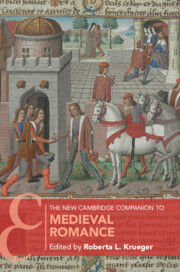Book contents
- The New Cambridge Companion to Medieval Romance
- The New Cambridge Companion to Medieval Romance
- Copyright page
- Contents
- Figures
- Contributors
- Acknowledgments
- Chronology
- Introduction
- 1 “For Love and For Lovers”
- 2 The Manuscript Contexts of Medieval Romance
- 3 Matters of Form
- 4 Authors, Narrators, and Their Stories in Old French Romance
- 5 Arthurian Transformations
- 6 Romance and the Medieval Mediterranean
- 7 The Crusading Romance in Britain
- 8 “Making Race” in Medieval Romance
- 9 The Construction and Interrogation of Gender in Old French Romance
- 10 Emotions as the Language of Romance
- 11 Medieval Iberian Romance
- 12 Medieval and Early Modern Italian Romance
- 13 German Medieval Romance
- 14 The Ends of Romance in Chaucer and Malory
- 15 French Romance in the Late Middle Ages and the Renaissance
- 16 Romance in Historical Context
- 17 Romance in Twentieth- and Twenty-First-Century Popular Culture
- Bibliography of Editions and Translations
- Index
- Cambridge Companions To …
- References
5 - Arthurian Transformations
Published online by Cambridge University Press: 11 May 2023
- The New Cambridge Companion to Medieval Romance
- The New Cambridge Companion to Medieval Romance
- Copyright page
- Contents
- Figures
- Contributors
- Acknowledgments
- Chronology
- Introduction
- 1 “For Love and For Lovers”
- 2 The Manuscript Contexts of Medieval Romance
- 3 Matters of Form
- 4 Authors, Narrators, and Their Stories in Old French Romance
- 5 Arthurian Transformations
- 6 Romance and the Medieval Mediterranean
- 7 The Crusading Romance in Britain
- 8 “Making Race” in Medieval Romance
- 9 The Construction and Interrogation of Gender in Old French Romance
- 10 Emotions as the Language of Romance
- 11 Medieval Iberian Romance
- 12 Medieval and Early Modern Italian Romance
- 13 German Medieval Romance
- 14 The Ends of Romance in Chaucer and Malory
- 15 French Romance in the Late Middle Ages and the Renaissance
- 16 Romance in Historical Context
- 17 Romance in Twentieth- and Twenty-First-Century Popular Culture
- Bibliography of Editions and Translations
- Index
- Cambridge Companions To …
- References
Summary
This chapter discusses ways in which the Arthurian legend was transformed between the twelfth and fifteenth centuries by French and English romance writers, focusing on the introduction of new characters, changes to the roles of traditionally central characters, and conflicting loyalties and values. Arthur is often displaced from the central role in the plot and can seem passive and ineffective. Gawain is the Top Knight in the English tradition, but Lancelot (a French addition) becomes increasingly important, not least because of his long affair with the queen, which is a contributing factor to the final collapse of Camelot. Family matters increasingly lead to conflicts of loyalties: Morgan le Fay is hostile to her brother, Arthur, and his Orkney nephews grow in number, some loyal but some treacherous. Mordred is not only Arthur’s nephew but sometimes also his son by incest, destined to kill his father. The Grail quest features first Perceval and then Galahad (Lancelot’s illegitimate son); its spiritual values challenge the ethos of secular chivalry and ennobling love. Does this quest bring glory to Arthur’s Round Table, or is it a critique of a fatally flawed society? Important variations in medieval approaches to the legend appear through this period.
- Type
- Chapter
- Information
- The New Cambridge Companion to Medieval Romance , pp. 73 - 87Publisher: Cambridge University PressPrint publication year: 2023



